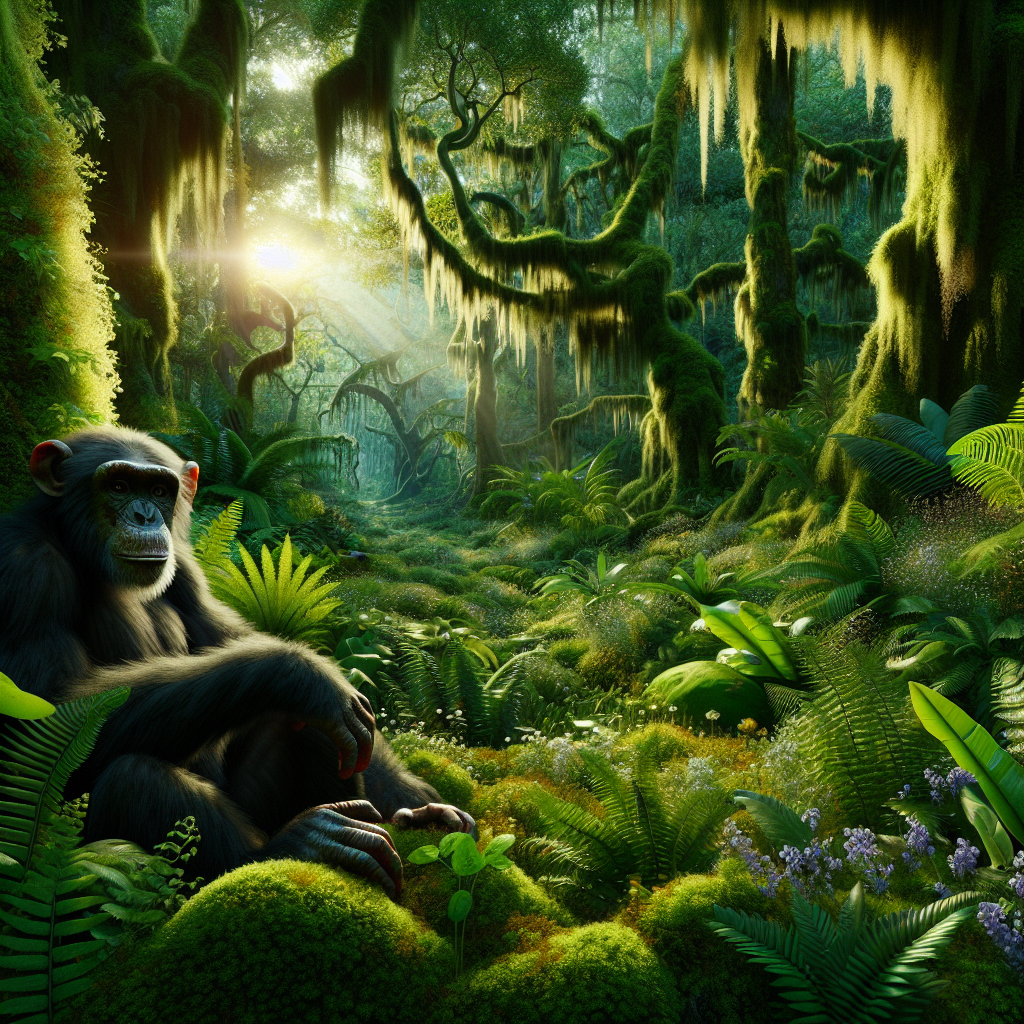Scientists have found that wild chimpanzees in Uganda eat certain plants that can help them feel better when they’re sick or hurt. The scientists watched the chimpanzees in the forests and collected samples of the plants they ate. They tested these plants and found that they can kill bacteria. The scientists think that studying these plants could help us find new medicines. Dr. Elodie Freymann from the University of Oxford spent four years watching the chimpanzees in the Budongo Central Forest Reserve. She collected samples of their poop and pee to check for sickness and infection. The scientists paid extra attention when the chimpanzees ate unusual foods like tree bark or fruit skin, because these could be plants that can help them feel better. One chimpanzee that was hurt was seen eating ferns, which were found to have strong anti-inflammatory properties. In total, the scientists collected samples from 13 different plant species and found that almost 90% of them could kill bacteria and a third had natural anti-inflammatory properties. All of the sick and hurt chimpanzees in the study got better. The scientists say it’s really important to protect these “forest pharmacies” so that future generations can benefit from them.
Original news source: Chimpanzees ‘self-medicate’ with healing plants (BBC)
🎧 Listen:
Slow
Normal
Fast
📖 Vocabulary:
| 1 | chimpanzees | Large primates that are closely related to humans |
| 2 | bacteria | Tiny organisms that can cause disease |
| 3 | medicines | Substances used to treat illnesses |
| 4 | infection | The presence of harmful germs in the body |
| 5 | unusual | Not common or ordinary |
| 6 | properties | Characteristics or qualities of something |
| 7 | species | Groups of living organisms that are similar |
| 8 | anti-inflammatory | Reducing swelling and pain |
| 9 | samples | Small parts taken to show what the whole is like |
| 10 | pharmacy | A place where medicines are prepared and sold |
| 11 | generations | Groups of people born and living around the same time |
| 12 | protect | To keep safe from harm or damage |
| 13 | scientists | People who study and research things |
| 14 | collected | Gathered or brought together |
| 15 | reserve | An area of land set aside for a special purpose |
Group or Classroom Activities
Warm-up Activities:
– News Summary
Instructions:
1. Divide the class into small groups.
2. Provide each group with a copy of the article or project it on a screen.
3. Instruct each group to read the article and summarize the main points in a few sentences.
4. After a designated time, have each group share their summaries with the class.
– Vocabulary Pictionary
Instructions:
1. Divide the class into pairs.
2. Give each pair a set of vocabulary words related to the article.
3. One student from each pair selects a word and draws a picture to represent it without using any words or letters.
4. The other student must guess the word based on the drawing.
5. After a designated time, have the pairs switch roles and continue the game with new words.
– Pros and Cons
Instructions:
1. Divide the class into small groups.
2. Assign each group a topic related to the article (e.g. the benefits and drawbacks of studying chimpanzees).
3. Instruct each group to brainstorm and discuss the pros and cons of their assigned topic.
4. After a designated time, have each group present their findings to the class and facilitate a class discussion.
– Opinion Spectrum
Instructions:
1. Create a line on the board or on a piece of paper with “Strongly Agree” on one end and “Strongly Disagree” on the other end.
2. Read out statements related to the article (e.g. “Studying chimpanzees can lead to new medical discoveries”).
3. Instruct the students to stand along the line according to their level of agreement or disagreement with each statement.
4. Encourage students to discuss their opinions with each other and have a class discussion based on the different positions.
– Future Predictions
Instructions:
1. Instruct each student to write down three predictions about the future of studying plants for medicinal purposes based on the article.
2. After a designated time, have the students share their predictions with a partner or small group.
3. Encourage students to discuss and debate the likelihood of each prediction coming true.
4. Have a class discussion and share some of the most interesting predictions.
🤔 Comprehension Questions:
1. What did scientists discover about wild chimpanzees in Uganda?
2. How did the scientists study the chimpanzees and the plants they ate?
3. Why do the scientists believe studying these plants could be helpful?
4. What did Dr. Elodie Freymann do during her four years of research?
5. Why did the scientists pay extra attention when the chimpanzees ate unusual foods?
6. What did the scientists find when they tested the ferns that one hurt chimpanzee was eating?
7. How many different plant species did the scientists collect samples from?
8. What is the importance of protecting these “forest pharmacies” according to the scientists?
Go to answers ⇩
🎧✍️ Listen and Fill in the Gaps:
Scientists have (1)______ that wild (2)______ in Uganda eat certain plants that can help them feel better when they’re sick or hurt. The (3)______ watched the chimpanzees in the forests and collected samples of the plants they ate. They (4)______ these plants and found that they can kill bacteria. The scientists think that (5)______ these plants could help us find new medicines. Dr. Elodie (6)______ from the University of Oxford (7)______ four years watching the chimpanzees in the Budongo Central Forest Reserve. She collected samples of their poop and pee to (8)______ for sickness and infection. The scientists paid extra attention when the chimpanzees ate unusual (9)______ like tree bark or fruit skin, because these could be (10)______ that can help them feel (11)______. One chimpanzee that was hurt was seen eating (12)______, which were found to have strong anti-inflammatory properties. In total, the scientists collected samples from 13 different plant species and found that almost 90% of them could kill bacteria and a (13)______ had (14)______ anti-inflammatory (15)______. All of the sick and hurt chimpanzees in the study got better. The scientists say it’s really important to protect these “forest pharmacies” so that future generations can (16)______ from them.
Go to answers ⇩
💬 Discussion Questions:
Students can ask a partner these questions, or discuss them as a group.
1. What is a chimpanzee?
2. How do you think the scientists collected samples from the chimpanzees?
3. Do you think it’s important to study plants that animals eat? Why or why not?
4. How would you feel if you were sick and there was no medicine to help you?
5. Do you like studying about animals and plants? Why or why not?
6. What do you think it means when the article says the plants have “anti-inflammatory properties”?
7. Why do you think it’s important to protect the “forest pharmacies”?
8. Have you ever seen a chimpanzee before? Where?
9. How do you think the scientists felt when they discovered that the plants could kill bacteria?
10. Do you think it’s possible to find new medicines from studying plants? Why or why not?
11. Have you ever been sick or hurt? How did you feel?
12. What do you think the scientists will do with the information they found about the plants?
13. Do you think it’s important to study animals in their natural habitats? Why or why not?
14. Why do you think the scientists collected samples of the chimpanzees’ poop and pee?
15. How would you feel if you were able to discover a new medicine from studying plants?
Individual Activities
📖💭 Vocabulary Meanings:
Match each word to its meaning.
Words:
1. chimpanzees
2. bacteria
3. medicines
4. infection
5. unusual
6. properties
7. species
8. anti-inflammatory
9. samples
10. pharmacy
11. generations
12. protect
13. scientists
14. collected
15. reserve
Meanings:
(A) An area of land set aside for a special purpose
(B) People who study and research things
(C) Groups of living organisms that are similar
(D) Characteristics or qualities of something
(E) Not common or ordinary
(F) Reducing swelling and pain
(G) The presence of harmful germs in the body
(H) Groups of people born and living around the same time
(I) Large primates that are closely related to humans
(J) Tiny organisms that can cause disease
(K) Substances used to treat illnesses
(L) To keep safe from harm or damage
(M) Small parts taken to show what the whole is like
(N) Gathered or brought together
(O) A place where medicines are prepared and sold
Go to answers ⇩
🔡 Multiple Choice Questions:
1. What did scientists find that wild chimpanzees in Uganda eat?
(a) Certain plants
(b) Insects
(c) Meat
(d) Fish
2. How did scientists study the chimpanzees in the forests?
(a) By capturing them
(b) By feeding them
(c) By watching them
(d) By taking them to a laboratory
3. What did the scientists find that the plants eaten by chimpanzees can do?
(a) Attract insects
(b) Cure diseases
(c) Kill bacteria
(d) Make the chimpanzees stronger
4. What did Dr. Elodie Freymann collect from the chimpanzees to check for sickness and infection?
(a) Samples of their fur
(b) Samples of their poop and pee
(c) Samples of their saliva
(d) Samples of their blood
5. What kind of foods did the scientists pay extra attention to when the chimpanzees ate?
(a) Unusual foods like tree bark or fruit skin
(b) Fruits and vegetables
(c) Meat and fish
(d) Insects and worms
6. What did the scientists find out about the ferns that one hurt chimpanzee was eating?
(a) They are poisonous
(b) They have strong anti-inflammatory properties
(c) They can kill bacteria
(d) They can cure diseases
7. How many different plant species did the scientists collect samples from?
(a) 5
(b) 20
(c) 10
(d) 13
8. What do the scientists say is important to do in order to benefit from the “forest pharmacies”?
(a) Destroy them
(b) Study them in a laboratory
(c) Feed them to the chimpanzees
(d) Protect them
Go to answers ⇩
🕵️ True or False Questions:
1. Scientists observed wild chimpanzees in Uganda and discovered that they eat certain plants to help them feel better when they are sick or injured.
2. Dr. Elodie Freymann from the University of Oxford spent four months observing the chimpanzees in the Budongo Central Forest Reserve.
3. Out of the 13 different plant species sampled, almost 50% of them were found to have bacteria-killing abilities, and a third of them had natural anti-inflammatory properties.
4. One injured chimpanzee was observed eating ferns, which were later found to have strong anti-inflammatory properties.
5. The scientists collected samples of the plants the chimpanzees ate and tested them, finding that they have the ability to kill bacteria.
6. The researchers believe that studying these plants could lead to the discovery of new medicines for humans.
7. The scientists ignored special attention when the chimpanzees ate usual foods like tree bark or fruit skin, as these could potentially have no medicinal properties.
8. Dr. Freymann collected samples of the chimpanzees’ waste to check for signs of health and cleanliness.
Go to answers ⇩
📝 Write a Summary:
Write a summary of this news article in two sentences.
Check your writing now with the best free AI for English writing!
Writing Questions:
Answer the following questions. Write as much as you can for each answer.
Check your answers with our free English writing assistant!
1. What did scientists find out about the plants that wild chimpanzees in Uganda eat?
2. How did the scientists collect samples of the plants the chimpanzees ate?
3. Why did the scientists pay extra attention when the chimpanzees ate unusual foods?
4. What did the scientists find out about the ferns that one hurt chimpanzee was eating?
5. Why do the scientists think it’s important to protect the “forest pharmacies”?
✅ Answers
🤔✅ Comprehension Question Answers:
1. What did scientists discover about wild chimpanzees in Uganda?
Scientists discovered that wild chimpanzees in Uganda eat certain plants that can help them feel better when they’re sick or hurt.
2. How did the scientists study the chimpanzees and the plants they ate?
The scientists watched the chimpanzees in the forests and collected samples of the plants they ate. They also collected samples of the chimpanzees’ poop and pee to check for sickness and infection.
3. Why do the scientists believe studying these plants could be helpful?
The scientists believe studying these plants could be helpful because they found that the plants can kill bacteria. By studying them further, they may be able to find new medicines.
4. What did Dr. Elodie Freymann do during her four years of research?
Dr. Elodie Freymann spent four years watching the chimpanzees in the Budongo Central Forest Reserve. She collected samples of their poop and pee to check for sickness and infection.
5. Why did the scientists pay extra attention when the chimpanzees ate unusual foods?
The scientists paid extra attention when the chimpanzees ate unusual foods because these foods could be plants that can help them feel better when they’re sick or hurt.
6. What did the scientists find when they tested the ferns that one hurt chimpanzee was eating?
When the scientists tested the ferns that one hurt chimpanzee was eating, they found that the ferns had strong anti-inflammatory properties.
7. How many different plant species did the scientists collect samples from?
The scientists collected samples from 13 different plant species.
8. What is the importance of protecting these “forest pharmacies” according to the scientists?
According to the scientists, it is important to protect these “forest pharmacies” so that future generations can benefit from them.
Go back to questions ⇧
🎧✍️✅ Listen and Fill in the Gaps Answers:
(1) found
(2) chimpanzees
(3) scientists
(4) tested
(5) studying
(6) Freymann
(7) spent
(8) check
(9) foods
(10) plants
(11) better
(12) ferns
(13) third
(14) natural
(15) properties
(16) benefit
Go back to questions ⇧
📖💭✅ Vocabulary Meanings Answers:
1. chimpanzees
Answer: (I) Large primates that are closely related to humans
2. bacteria
Answer: (J) Tiny organisms that can cause disease
3. medicines
Answer: (K) Substances used to treat illnesses
4. infection
Answer: (G) The presence of harmful germs in the body
5. unusual
Answer: (E) Not common or ordinary
6. properties
Answer: (D) Characteristics or qualities of something
7. species
Answer: (C) Groups of living organisms that are similar
8. anti-inflammatory
Answer: (F) Reducing swelling and pain
9. samples
Answer: (M) Small parts taken to show what the whole is like
10. pharmacy
Answer: (O) A place where medicines are prepared and sold
11. generations
Answer: (H) Groups of people born and living around the same time
12. protect
Answer: (L) To keep safe from harm or damage
13. scientists
Answer: (B) People who study and research things
14. collected
Answer: (N) Gathered or brought together
15. reserve
Answer: (A) An area of land set aside for a special purpose
Go back to questions ⇧
🔡✅ Multiple Choice Answers:
1. What did scientists find that wild chimpanzees in Uganda eat?
Answer: (a) Certain plants
2. How did scientists study the chimpanzees in the forests?
Answer: (c) By watching them
3. What did the scientists find that the plants eaten by chimpanzees can do?
Answer: (c) Kill bacteria
4. What did Dr. Elodie Freymann collect from the chimpanzees to check for sickness and infection?
Answer: (b) Samples of their poop and pee
5. What kind of foods did the scientists pay extra attention to when the chimpanzees ate?
Answer: (a) Unusual foods like tree bark or fruit skin
6. What did the scientists find out about the ferns that one hurt chimpanzee was eating?
Answer: (b) They have strong anti-inflammatory properties
7. How many different plant species did the scientists collect samples from?
Answer: (d) 13
8. What do the scientists say is important to do in order to benefit from the “forest pharmacies”?
Answer: (d) Protect them
Go back to questions ⇧
🕵️✅ True or False Answers:
1. Scientists observed wild chimpanzees in Uganda and discovered that they eat certain plants to help them feel better when they are sick or injured. (Answer: True)
2. Dr. Elodie Freymann from the University of Oxford spent four months observing the chimpanzees in the Budongo Central Forest Reserve. (Answer: False)
3. Out of the 13 different plant species sampled, almost 50% of them were found to have bacteria-killing abilities, and a third of them had natural anti-inflammatory properties. (Answer: False)
4. One injured chimpanzee was observed eating ferns, which were later found to have strong anti-inflammatory properties. (Answer: True)
5. The scientists collected samples of the plants the chimpanzees ate and tested them, finding that they have the ability to kill bacteria. (Answer: True)
6. The researchers believe that studying these plants could lead to the discovery of new medicines for humans. (Answer: True)
7. The scientists ignored special attention when the chimpanzees ate usual foods like tree bark or fruit skin, as these could potentially have no medicinal properties. (Answer: False)
8. Dr. Freymann collected samples of the chimpanzees’ waste to check for signs of health and cleanliness. (Answer: False)
Go back to questions ⇧













